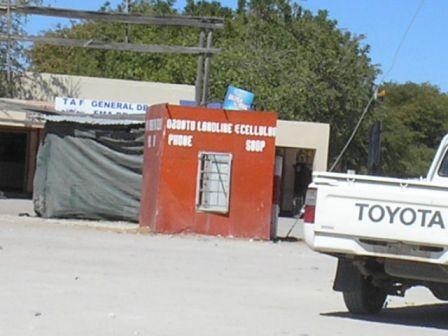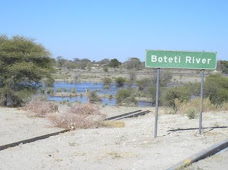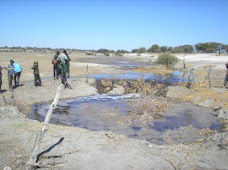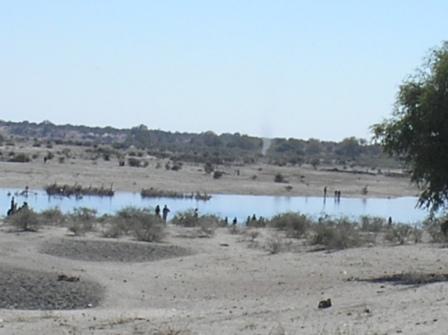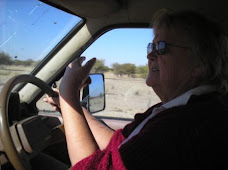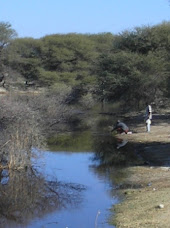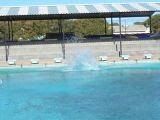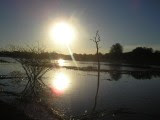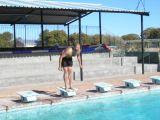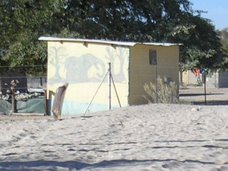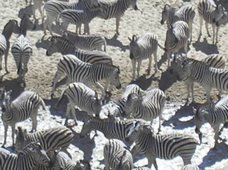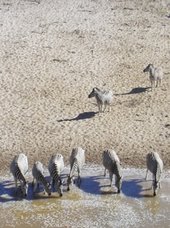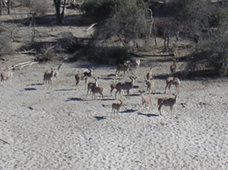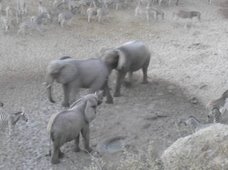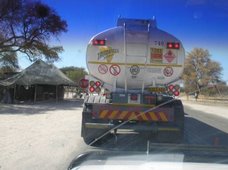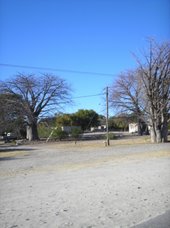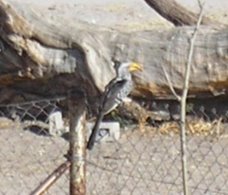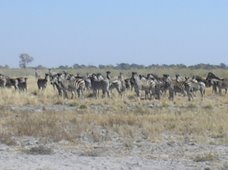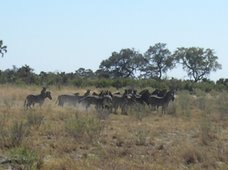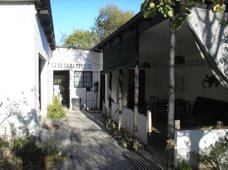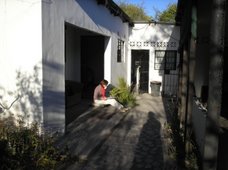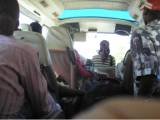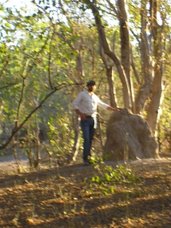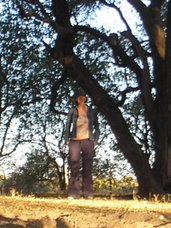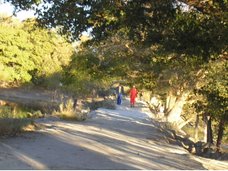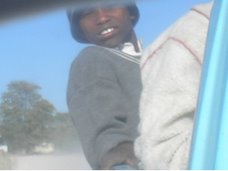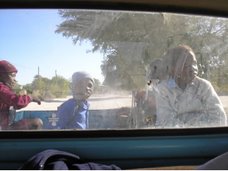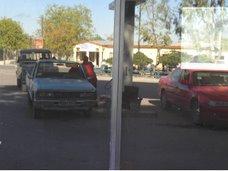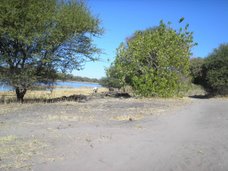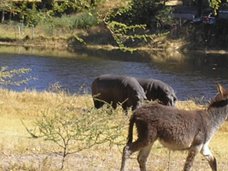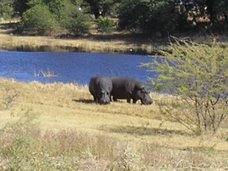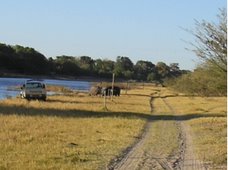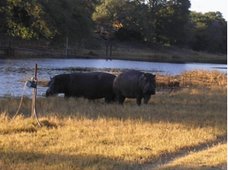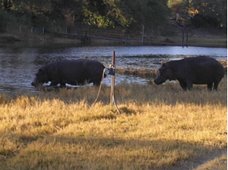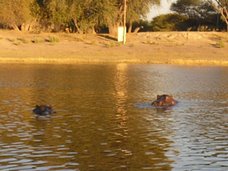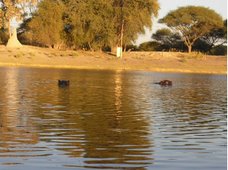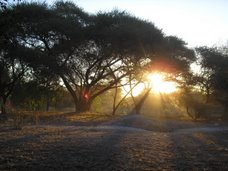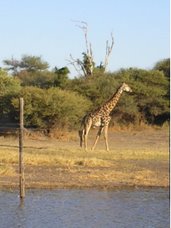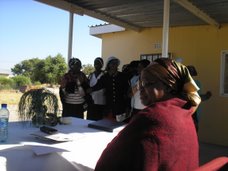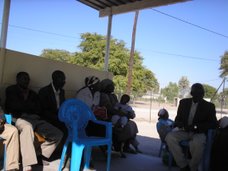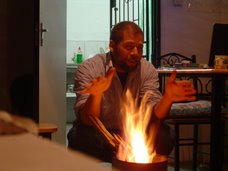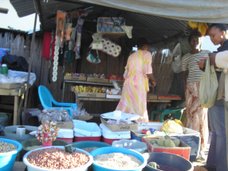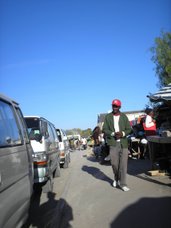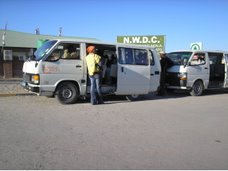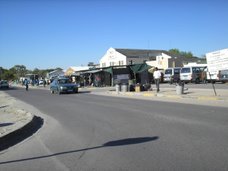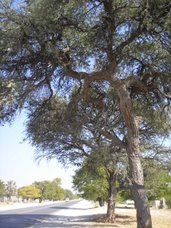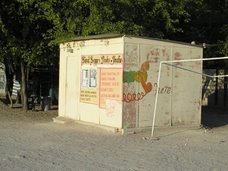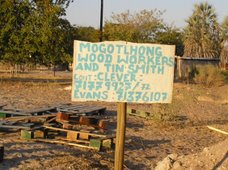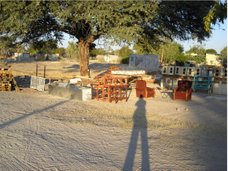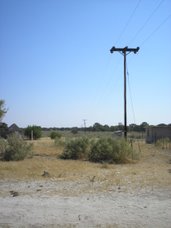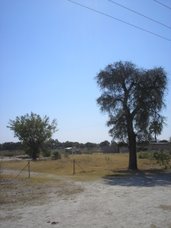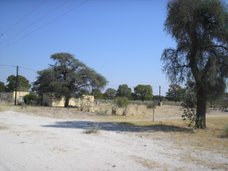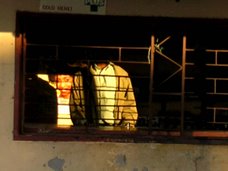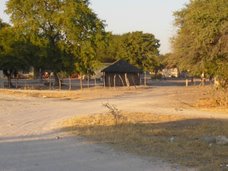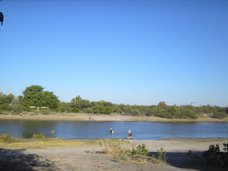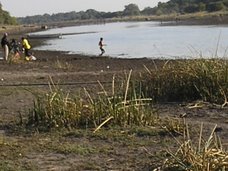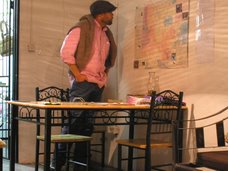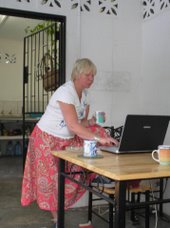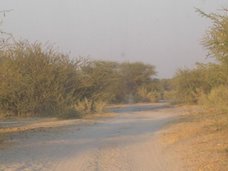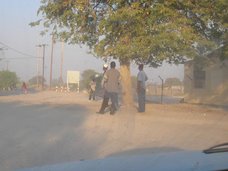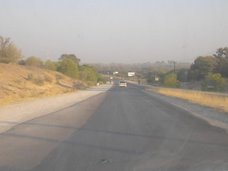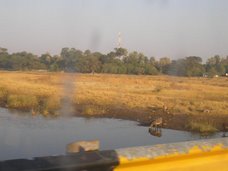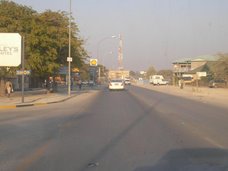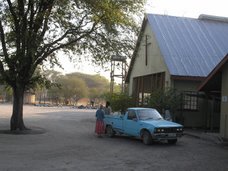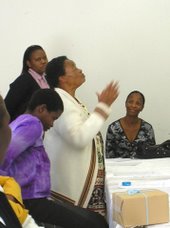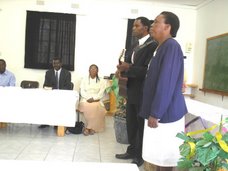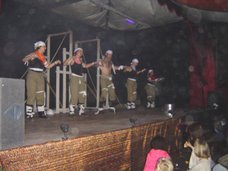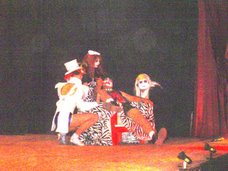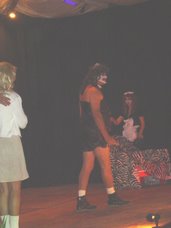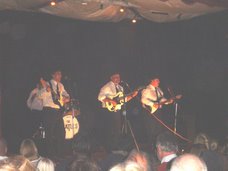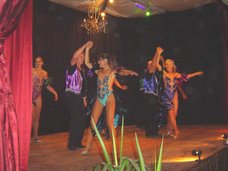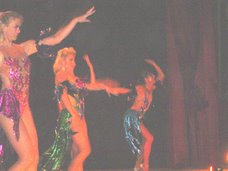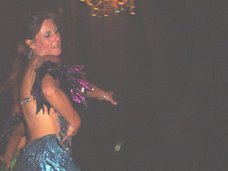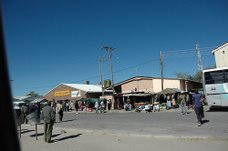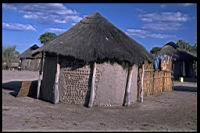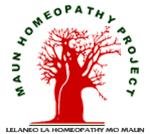Wednesday, November 14, 2007
IN DEFENCE OF HOMEOPATHY
In defence of homeopathyJeanette WintersonTuesday November 13, 2007The Guardian
Picture this. I am staying in a remote cottage in Cornwall without a car. I have a temperature of 102, spots on my throat, delirium, and a book to finish writing. My desperate publisher suggests I call Hilary Fairclough, a homeopath who has practices in London and Penzance. She sends round a remedy called Lachesis, made from snake venom. Four hours later I have no symptoms whatsoever.
Dramatic stuff, and enough to convince me that while it might use snake venom, homeopathy is no snake oil designed for gullible hypochrondriacs. Right now, though, a fierce debate is raging between those, like me, who trust homeopathy because it works for them, and those who call it shamanistic claptrap, without clinical proof or any scientific base.
There have been a number of articles in the press recently criticising homeopathic remedies as worthless at best, and potentially lethal at worst, if they are being taken instead of tried-and-tested conventional medicines for conditions such as malaria or HIV.
I have found myself cited, and drawn into this, because I am on record as supporting homeopathic practice in general, and in particular the Maun homeopathy project, a clinic in Botswana set up by Fairclough.
http://www.guardian.co.uk/g2/story/0,,2209998,00.html
Follow the link to the full article.
ROWLAND AT HOME
Sunday, August 26, 2007
Journey To Ubuntu, The Spirit Of The Ancestors
We’ve had another wonderful weekend as we traveled south west, past Sehitwa down to D’Quae Q’Are to the Kuru San dance festival. Once again we took to the road with the remarkable Marty who pointed out to us the Thamalakawe fault along which our river runs and the ancient shores and sand-bars of paeleo Lake Ngami.
We saw some very fascinating things concerning ubuntu, the heritage of the ancestors, the ancient and contemporary landscape and Botswana’s delicate relationship with water. As we left Maun and and passed the Hereo village Marty began to describe the intricacies of Ngamiland’s subteranean waters. Lake Ngami has been dry for about 160 years. Sehitwa is situated on it’s shores and on the map appears next to a large expanse of blue. However, in reality the best you could expect to see was a few muddy pools. The most striking evidence of the absence of this water is the dead Lead wood and acacia trees. These trees are incredibly slow growing and those of any reasonable size are likely to be around 150 years old. Along the road as we passed out of Maun we could see a great many of these trees recently dead indicating that there is gradually less and less water flowing underground.
Further on we came to a great Baobab tree. Again, in this desert region these trees are incredibly slow growing and the one we saw could be up to 2000 years old. It’s smooth bark felt like stone and in it’s branches were growing it’s furry fruit. Marty pointed out to us a square outline on it’s trunk. This scar showed where people had stripped the bark in order to make cloth at least 300 years ago. This remonds me of the artefact we found when we gathered wood on the way back from seeing the waters of the Boteti flow again.
So, there we are, just off the old Samedupi road colllecting firewood when we come across a bleached white piece of timber, deeply weathered, about 1.5 meters long with grooves about it’s circumfirence. So we brought it back with us to figure out what it might be. Batsamai had the answer. It was a tool in the tanning and leatherworking trade and would have been suspended from a tree by ropes running around the grooves. Now, this piece of wood was leadwood, which used to be used for cart axles because of it’s durability. This piece was bleached white and deeply grooved along it’s grain so that although it had been worked it looked like an outer covering of leadwood bark. Forr the wood to have aged so much it must have been at least 200 years old. A piece of wood with so many stories to tell because it would have heard the ancerstors talking as they worked and then lay and watched as the cattle drivers passed with their herds, as woodgatherers passed and seen the old Samedupi road being built.
So, on we went and saw to our delight a much younger baobab growing beside the road and acacia’s beginning to put out yellow blossoms here and there. I got my first sight of real live wild ostriches. A pair of females were pecking beside the road apparently oblivious to passing cars.
On and on and up and over the edge of the Thamalakawe fault, through the vet fence at Kuke where we were in two minds whether or not to head off to the central Kalahari game reserve as it was relatively nearby but we’d set our hearts on going to the festival so on we went. Along a long gently curving road bounded by acacias and leadwoods. No Mophane trees though. There’s a Mophane line just southwest of Maun beyond which no Mophane grow.
We found D’Quae Q’Are and were searched at the gate for alcohol. During the festival no alcohol is allowed on site as it pollures the vibe for anyone likely to go into a trance while they dance. Smoking is forbidden at the dancing arena for this reason too.
We drove along a straight but bumpy track through the game reserve where the event was being held. We were passed by Ian Khama, the Vice President’s entourage going in the opposite direction and a bus full of schoolchildren who shouted ‘I love you’ and made Marty’s day as we passed each other.
I’d love to be able to describe the dances to you in great detail but it has been a long day. One of the most striking things about the dance groups is the role of the men and women. The women clap and sing and go out and dance in two’s and threes. They are accompanied by up to three men. One carrying a stick, one a fly whisk and one both stick and flywhisk. They provide a contrapuncta lrythmn of their own by stamping their feet in and shaking the belts of seeds which are wound round their legs. Men dance differently from women too, they are generally bent at the waist with their shoulders hunched and their elbows out looking awkward but dancing gracefully. For the women there’s more freedom of movement, they look more relaxed without their shoulders hunched.The other thing which struck me was the range of ages and costumes. One group were particularly striking as there were dressed in contamporary clothes. They struck me because it brought home to me the reality of the San people’s lives. Their no longer the pure, simple bushman characterized in ‘The Gods Must Be Crazy’ but fully paid up members of the twentieth centuary albiet with a unique culture and heritage.
Suffice to say, everyone was enjoying themselves.It was a place for people from all over to meet up and rekindle aquaintances and catch up on gossip, buy tasty food, look at something and generally hang out in a festive atmosphere. Hey, I saw my fisrt Hartebeest there too. They were having a party too with a couple of Zebra and a wildebeest. Hartebeest look like elegant wildebeest. Where wildebeest are grey and shaggy hartebeest are golden and clean lined and the males have impressive slowly spiraling and curved horns. They have a similarly long face to the wildebeest and theirs is accentuated by a black line running down the middle of their faces from forehead to nose making them appear like masked animals.
I’ll put up some pictures from this trip and scenes from Maun and our trip top Boteti in the coming days. We’ve actually been pretty busy in the last couple of weeks and I’ve just been enjoying the opportunity to relax after work,. So sorry for the absence of pictures recently. Things aren’t going to slow down either. We’ll be in Shorobe on Wednesday and Friday next week to attend a convention of all the local HIV support groups., That’s going to be very interesting and a lot of fun too though I guess I will have left Botswana by the time I have time to tell you guys about it. Until then, take it easy.
Friday, August 17, 2007
Exploring With Marty: The Return Of The River
Here’s the reasons why. The fence is sparsely gated and a gate only works when it is closed. Most of the gate-posts we passed were ungated as gates are very useful to people elsewhere. Those gates we did see were either left open or mangled beyond repair. Long stretches of the fence were non existent for one reason or another. In many places the fence had been trampled down by either people or animals and ceased to serve it’s purpose.
Why is this such a problem? The fence is there to stop cattle and other livestock getting onto the road and being squashed. When there’s no fence the cattle get out and graze along the sides of the road as there is very good grasss there. So Marty’s involved with getting the fence repaired etc. We drove out of Maun at half eight this morning and traveled along the road playing a sort of Eye-Spy car game for sections of fence which was non existent, bent and climbable, gated and closed, gated but with no gate, gated with an open gate and gated with a mangled gate. We did pretty well.
This journey brought us to the turning for Samedupi so we went down there to see whether any water had reached the bridge. We were travelling through fully rural Africa . We’d left the builders merchants, car spares shops, garages, take-away’s and liquor rests way behind us on the outskirts of Maun.
The way was lined with species of acacia, sage brush, mophane and mogotho trees. Every now and then we’d see compounds with one or two ntlo or rondavel houses, a big tree for shade and people going about their business. We’d pass donkey carts laden with containers for water and usually a couple of boys or an old man at the controls.
At Samedupi we got the first happy surprise of the day. Water had begun to flow in the Boteti river, a thing not seen for at least 20 years. It has been left in standing pools near Makalamabedi higher up the river in years prdeviously but had never flowed as far as Samedupi in about 20 years.
At the bridge it was coursing along like a mill-race and Marty pointed out that it was deep because the silcrete outcrops were submerged! Silcrete appears to be a little understoodmineral which forms somehow along rivers. It appears in stratified or nodular outcrops depending on how it was formed and can look like tree branches, trunks or rootrs which have become fossilised. The bits I saw reminded me a lot of the type of flint nodes which we found on Har Karkom when I was working with Professor Emanuel Anati’s yearly expedition there to catalogue the rock art. After all the Negev had once been a sea, and then had lakes and rivers. Thinking along those lines I asked Marty if she’d ever come across anything like the bulbusim you can find in the Negev and she had but much smaller and had at first mistaken hem for bolas stones.
We met a couple of local men on the bridge who were delighted with it and who pointed out fish to us. You could see on either bank people filling water and nearby work was going on on a pipeline. Marty found an acheulean hand axe on the bank, highly patinated. What marks these hand axes out is that they are shaped and pressure flaked before they are struck from the core.
We then continued on to Makamalabedi. Makamalabedi is a really pretty village. All the compounds are very neat and tidy looking and there are often well tended plants in them. Many of the traditional ntlo houses were decorated and had the traditional lowapa, a low wall creating a smaller space in front of the door. The veterinary fence that we passed through on our way to Meno A Kwena extends through here also and we had to pass the checkpoint. The friendly policeman there told us where we could get down to the river and so we went through the village and down there.
On our way we met a family in their Sunday best on their way to church and asked them when the river had arrived and it was only last night. We could see on the banks many people enjoying themselves. Children were splashing around as women and girls came and went with water containers. And everyone was very happy and you can understand why if you live in a desert next to a river which possibly hasn’t flowed in your lifetime.
We decided we’d carry on and see if we could find the leading edge of the river creping forward across the dusty earth. We went off the tarmac road and hugged the river banks. Along here were great molapo fields reacing almost from he crest of the bank down into the middle of the river beds. These are fields marked out by fences made from piles of acacia branches and saplings. They are quite an ingenious sort of agiculture. The idea is that you build your field and wait for he river to rise. Once the river has risen intoyour field you’re OK. Then as the water retreats you plant your crops and they are rooted well as trheir roots follow the retreating river water.
Down in the river beds we could see smaller area’s fenced off like this which were wells people had dug to reach the ground water. We had lunch in the shade of a tree high and dry up on the bank. Afterwards I went to look for scorpions in amongst the silcrete rocks on the river bed and scout a possible route back to the leading edge of the river through the field of spiky silcrete. What I found was the pelvic bones of a cow still joined at the symphysis and making a great mask for a sangoma. I took it back to where we were all sitting and Marty claimed it in the name of her grand-children.
I forgot to mention that on our way we’d lost sight of the river and when we came back to it it was dry as it ever was. Marty who can read landscapes like you can read the letters of this blog explained why. We could see that the river curved back to where we had last seen it and this curve was caused by the river having to edge round a large formation of silcrete below the topsoil.
OK, you’re up to speed now. So after lunch we continued back along the riverbank towards Makalamabedi weaving down to the river bed, up the bank and from one side of the riverbed to the other and passing molapo fields and wells along the way. Makalamabedi came back into sight above the river on the far bank then we emerged from the bush and saw a backie parked and a cluster of people so we headed towards them. The backie turned out to belong to Water Affairs and we’d found the leading edge of the river being very dramatic.
The river had found itself a nice narrow channel to creep along around the edge of the silcrete deposit. It had just arrived at the lip of a well dug in the river bed and the men from water affairs had broken the lip to allow the water into the well and replenish the groundwater. The water poured over the edge in a healthy torrent and to the delightof us and the onlookers swiftly filled the well and spilled over the edge and began to flow forward through the parched grass like so many glistening snakes.
So, how is it that a river which has been dry for 20 years suddenly return to life? The reason is good rains in Angola . One of the men from water Affairs told us that the waters were continuing to rise in the panhandle, i.e. the point of entry iof water to the Okavango Delta in northwestern Botswana.The river was a beautiful thing to see flowing through the desert, reflecting the blue of the sky and glittering invitingly through the trees. Just looking at it you can feel its coolness and really appreciate its importance, here in the desert as a source of life. This was something which I had never seen before, a river in the desert returning to life and I was sharing this amazement with the people who lived here some of whom had never seen the Boteti river flow in their lives. I may not see such a thing ever again in my life.
Birdie Time
Friday Night Pub Quiz At Matshwane School
The table next to us were beefy Afrikaans pirates, some people came in fancy dress. They made a reall noise but were very funny and good fun. There was easily a hundred people in the great hall and like all Maun social events became a little too much of a good thing towards the end. But let me tell you what the good things were. Fun was the biggest good thi ng. There were hoots and cat-calls and local in jokes while the questions were being asked. The Dominatrix from the Maun charity concert was in charge of questions and crowd control. She’d done her best to make herself look like Ane Robinson of Weakest Link fame but in attitude she made Anne look like a drowned pussy-cat.
Then there was the food, provided by the schools Indian contingent. They had prepared a succulent chicken curry with REAL ROTI that was one of the highlights for me. Then there was meeting people. Anna-Lise is good fun but she was way down the other end of the table. I also met a woman who had surprised me that lunch time by saying hello to me in Hilary’s. She was one of those people who look dreadfully familiar but one can’t place. Anyway, she was very nice and very pleased to know that there were homoeopaths in Maun. Lutz was a funny guy and most of what we said to one another resulted in laughter on both sides. Karaoke was also a good thing. Instead of questions, one segment was singing. We all had to sing as a team. It’s Not Unusual by the inimitable Tom Jones was our song and I am pleased to say that Anne and I gave a good account of ourselves on backing vocals. But consider, 8 tables taking about 5 minutes each to get to the front and get their song set up and then sing about 2 minutes of it. Christ, it went on for almost an hour! The good thing was, the tunes were all danceable so that’s what was done.
By the time the winners had been announced, raffles drawn, other prizes handed our etc. It was one o’clock AM. And still there had to be the disco! Most people left including us as Hilary had taken us there and was heading home. The usual hard core of troublemakers stayed and with a regretful backward glance we left.
Thursday, August 09, 2007
A KUDU REVEALS HIS DEATH
I would get just to the edge of his comfort zone and off he'd go, kicking his heels up and disapearing into the trees and sage brush and I'd continue in the same general direction and get glimpses of him ahead of me before he charged off again. This went on for about an hour until I emerged into a clearing and there he was on the other side striking a classic pose with his body in profile and his face towards me displaying a remarkable pair of spiral horns and bigpink funnel-like ears. The early morning sunlight was slanting down through the branches and creating a wonderful wilderness scene. By a miracle he stood still long enough for me to take a photograph of him before he skipped off again.
He gave a hop skip and a jump and appeared to disappear into a hole behind some bushes. Curious, I thought, and walked as quietly as possible over there. As I got closer I could see the Kudu lying on the ground. At first I thought I had surprised him taking a dust bath and he was playing dead, but no. This was a reall dead Kudu.
I had to say thanks to the Kudu for letting me have his photograph and letting me get this close to a real wild African animal and share his space. I could have touched him if I had wanted to but I thought it was best to let him have his last moments in peace.
As I slowly left the clearing pondering on what fate led me to see a Kudu, a real , live , wild African animal keel over and die of old age like that, I almost walked into a young Girraffe, minding his own business and quietly chewing the cud.
He was kind enough to let me draw his body, couldn't fit his head on the page! I've some picasso-esque sketches of his head though which he kept moving around. I saw three giraffes in all, one a mature female who galloped in silent slow motion into the trees! They're incredibly beautiful animals. And when they run, even with trees, bushes and branches all around there is absolute silence, it's like watching a dream!
Sunday, August 05, 2007
Rowland's African Day

However, things changed for me on Saturday when I had a bit of an odyssey. Saturday was the day Noah was meant to visit and check our poor weak backie out and see what was wrong with it and put it right. Anne elected to stay behind and wait for him as she was sick and tired of driving our sick and tired backie around. So I went in to town.
My first stop was at the barbers. I had intended tosee the guy again who Alex had reccomended at airport junction but he was not around so I walked up to Old Mall as there is a profusion of barbers shelters there.
The day was bright and the air was cool as I walked into town as it was not yet ten o’clock. It’s a nice feeling to walk along roads which you normally drive down in the heat of midday, full of traffic between one appointment or another and these roads are quiet and the traffic moves slowly.
As usual there were crowds of people and vehicles outside shoprite, combies still jostled for position at the rank and the soundsystem still played fluid rythmic tunes into the air but I had time to take it in. The bright light forces you to squint and this narrows your field of vision to a space immediately in front of you and the environment is felt rather than seen until you reach a patch of shade and can widen your vision and take things in.
You can see big built Batswana middle class families coming and going at shoprite in big 4X4’s, tiny barefoot children with tinier siblings stand in groups intent on childish things, there are young women getting their hair braided in the shade of trees and awnings, phone credit hawkers in yellow vests break away from the crowds at the bus station like free electrons from the nucleus of an atom, flash youths in baseball caps, polo shirts and ripped jeans prowl the mall, young guys stand in groups chatting, laughing, smoking shouting out to their friends passing in cars, great stately Hereo women in brightly colored cloth sailing through the dust and crowds, gents in dark two-piece suits, collar and tie wearing stinge brim trilby’s looking like CIA men.
Like the Indian barber who practices his art on the street in the shade of a tree the barbers of Maun work in shacks made from planks and shade netting which provide a cool cave like shelter from the bustle of the street. Inside written in felt tip on the wall is the tarrif and below it are glued fragments of a mirror in which you can see your portrait as Picasso might have painted it.
You can choose an office cut, an English cut, a brush cut, a brush cut punk, or just a shave-no-style. Not knowing what to choose I asked the barber to make my hair short and smart and waited for the sesult.
Anne and I are hoping to include some barbers signs in the Sign Safari. They all appear to be in the same hand and include 3 heads which look like they are Batswana celebrities copied from films or newspapers. And, they all appear to advertise 3 styles, short, very short and shiny. I was fortunate and came away with a sort of Matt Gloss, which suited me fine.
I then turned my footsteps down Tsheko Tsheko road, past Choppies another big supermarket on one side and the victorian looking general dealers, butchers shop and electrical dealers on the other, with it’s concrete arcade and cool, dim, cavernous shops entered by a single door and smelling of dust and dried goods. Down Tsheko Tsheko road (which means Court-Case Court-Case Road) to the 4 way junction and turned left at the Hereo settlement corner and headed down to the small bridge which would take me to the Francistown road.
On my way there I passed students in their blue uniforms, I was passed by a wedding party driving slowly and tooting, a group of singers in lime green shirtsand orange waistcoats belting out songs from the back of a backie and giving thumbs up to everyone they pass, donkeys drowsing by the side of the road, herds of apparently unacompanied goats coming upo the embankment beside the bridge, horses wading in the river nibbling reeds, young people looking as though they are waiting to meet other young people on the bridge and finally I turn right, onto the Francistown road.
The Francistown oad is long and straight and in the full heat of the day, I pass builders yards and garages and the take-away/liquor rests that we pass on our way back from the pool which look so lively and inviting in the light of a Saturday evening. Cars pull up and drive away, a few people hang around outside drinking soft drinks and talking into mobiles, huddles of people with there baggage stand in the dust in the shade waiting for the hourly Francistown combie.
I reach the Ubuntu Cellphone & Landline shop and remember that I’ve not year eaten breakfast. But first, a note on Ubuntu. What is Ubuntu, Mageu maize milk ‘Salutes the Spirit of Ubuntu’, a liqueur made from Morula trees is decorated with ‘Ubuntu Beads’. Mary tells me that Ubuntu, roughly translated means ‘ancestral spirit or the soirit of the ancestors or something very traditional.
I head for the second Take-Away/Liquor-Rest outside of Maun, the Boseja Take-Away. These places, like the general dealer and butchers I mentioned earlier have a victorian appearance, being a single storey L shaped block of a building with the roof coming down low over the walk in front of the stores and making an arcade. These are the parts of Maun that really give it it’s frontiers-town atmosphere. Again the stores inside are dim and quaint knocked together looking. The Boseja Take-Away consisted of a counter behind which stood three big coke and beer fridges, full of beer, coke, softdrinks and things to be kept cool. On the counter in a glass prism were bags of fresh doughnuts and sliced grubby looking bread (aside from Hilary’s home-made bread available in loaves from the coffee shop bread is in a pretty low stageof evolutin here) and plates of Chicken & Macaroni, Chicken & Rice, Chicken & Papa.
There was a hand drawn and decorated ‘halal’ sign over the kitchen door and the place was run by a smiling, friendly Indian man with big Indian hair and a moustache. He was very helpful in explaining the intricacies of his menu and so I chose the chicken and macaroni which was spiced up by a big blob of ketchup. As I dined I was able to appreciate the idiosyncracies of decoration within the Take-Away. The walls were a smoky orange and were overpainted with abstract unmistakeable tiger stripe patterns. What lent the place a disturbing quality was the addition of about 4 pairs of Tigers’ eyes peering through the jungle and looking hungrily at the customers as they ate their chicken.
MMMM! That filled a yawning chasm at my core and I set off bouyed by a healthy balance of spices, e-numbers, protein and carbohydrate for my weekend swim.
I had still further to walk before the giant watertower on stilts which marks Matshwane school appeared. I let myself in as there was no old deuteronomy guarding the gate and went to the pool. Walking round to the deep end the air felt warmer than usual. I steeled myself to dive into the icy night cooled waters and dived in. Yet, I was pleasantly surprised to find that the water wasn’t quite so cold and when I reached the other end of the pool I was even happier to find that I was withouth the urge to leap out of the pool, dry off and bake for the rest of the day. I lounged for a bit with my elbows on the side and enjoyed the contrast of the hot sun, warm breeze and now invitingly cold water.
I did 18 lengths in two sessions with a baking out period in between. I was once again pleasantly surprised at my stamina which I now, on reflection ascribe to the running I now do every other day. As I knew I had a long walk back into town and dinner at Marty’s at 6 I left at about 3.30 while the sun was still hot.
The problem now was how to get home with the greatest expedience without having to walk home the way we drive as it is a very very dusty road. The easiest way would be a combie to the big bridge and then walk down along the river. This is what happened and so I was able to enjoy a walk home along the river in the beautiful African afternoon light.
Friday, August 03, 2007
आ वाल्क ब्य थे रिवर / A Walk By The River
Here you see some pictures from a recent walk along the river bank and an exhibit from the Sign Safari। नमस्ते, हिंदी रेअदेर्स! वेल्कोमे बैक!हेरे यू सी सोम पिक्टुरेस फ्रॉम आ रेसन्त वाल्क अलोंग थे रिवर बैंक ऎंड अन लुठेरण चर्च थे ऎंड वी।
The sun is begining to linger longer in the sky in the evenings and the river is higher than ever and is a very beautiful place to be in the evening. This is good as our lives here are beoming busier by the minute. more and more patients are visiting us at the private clinic. This is good as the patients who pay to see us there help to support the free homoeopathy clinics we run at The Lutheran ChurchThursday is by far our busiest day. It is a full day at the Lutheran Church Clinic and we अरे now seeing around eight patients each। Patient numbers have been gradually creeping up on a Thursday and down on a Monday because people have begun to think that Thursday is our quiet day. So we've been asking our patients to come for their follow up visits on a Monday.
Wednesday is quite a hard day as it is the day we see our home visit patients. As I have said before these consultations are hard because the patients are very sick and bedridden. The consultation is haarder because you are in a room with a very sick person, their relatives our translator and another homoeopath. One can feel concerned about the expectations of the patient and their family, concerned about intruding into a persons home with a great caravan of people as well as trying to come to a decision about how to prescribe and handle the case.
You need a cool head to do this and it's not easy but thankfully our days were not so full as they are now when I first startred. This gave me the chance to understand our prescribing method and the dynamics of our various consultations. I feel comfortable now about involving the patients relatives and our interpreter in the consultation and using their input and insights into the case. It was something I did in the past as a matter of form but now it feels like a natural and comfortablepart of the consultation.
We've got a good protocul between us as homoeopaths, Anne and I which we organised when there were three of us including Julia. We go through the cases before the home visits to get an undertsanding of the cases and decide who will take the case and who will facilitate the prescription. This gives the prescribing homoeopaths two heads to think with and makes the vexed questions about remedies and potency easier to overcome if the case is difficult.
Still, it's a hard days work. Thankfully we get on well and take care of each other. We've both got experiences and insights to share and have a good laugh when we're not working. I'm glad to say we're a good team!
Thursday, July 26, 2007
Three Patients Sitting In The Sun.
The patients’ strength makes their condition all the more poignant as we meet very strong people who are imprisoned in their own bodies through weakness. You can hear their strength in their voices, see it in their eyes or hear it in their words and it makes them appear in a very pitiful and tortured state as they cannot fend for themselves or engage with the world at large any more.
Seeing this strength although saddening to see imprisoned in a bed makes me optimistic that the patient will in time recover and this week I’ve seen this strength win through.
Today we were very happy to see three of our patients who were bedridden a week ago sitting outside in the sun. One was the albino patient I described in an earlier posting. Her first words when we met her were ‘I’m well!’. Her ulcers were clearly healing and she was very pleased to show us the progress they were making whereas at our previous visit shewas very weak and in a lot of pain and her ulcers were open wounds.
Our second patient had been in bed for months with diarrhoea and vomiting. Today she was sitting in her yard in the shade of a tree, proud to tell us that she could walk to her outhouse and back. Next time, she told us ‘You’ll see me cooking’.
Our third patient had also had constant diarrhoea which was now improved. Like the other patients she was sitting in her yard in the sun with her mother, her daughter and her grandchildren who were all playing at ‘foreigners in a decrepit pick-up stuck in the sand’.
I’m not describing people rising from the dead here. In all three cases there is a long way to go before they are as healthy as they’d like to be but the fact that they are out of bed, have more physical comfort and energy than before and doing things they enjoy is a big step for them on the road to recovery.
I’m pleased to say that many of the patients I am seeing now are improving or are returning to homoeopathy after a long time of being well. I’m not saying that this is all down to my sudden appearance on the scene. It is more due to the strength which the patients themselves posess and the many other homoeopaths who have added their skill to the proces of recovery.
The Flexibility of The Triad Method.
***The patient did well on their first and second prescriptions but they have returned. Their joint pains have returned but they find that they are now worse at the end of the day when they are at rest. They have to keep moving to keep the pains at bay. They began again around the time their children were threatened with expulsion from school because they were late with school fees (Everyone has to pay school fees in Botswana whether government or private school). The patient became worried for their children's future and took on extra work. Nothing much else worries them aside from their families welfare and their responsibilities.
In this case the aetiology of the joint pains and their characteristic of being worse for rest and better for continued motion indicates not Bryonia but Rhus Tox. The patients underlying constitution and background remain unchanged so far so the prescription can be repeated with the Bryonia, the initial remedy for the patients joint symptoms being changed for Rhus. Tox. Calc and Carc can be repeated as before.
More Medicine of Experience.
To make this easier I’ll give you an example of triad prescriptions for the sort of cases we often see. The cases given below are outline examples as a full case taking would be too much to present.
*** A patient has begun to get joint pains which are worse on motion and better for rest, these areaccompanied by a terrible headache which makes them just want to sit still and not be bothered by anybody. They naturally have become very bad tempered. Their focus in life is their home and family as they had to care for younger siblings and older relatives from an early age their parents died of cancer. They have recently had to cope with a bereavement and now care for another family members’ children. They take this responsibility very seriously. Their major worries are the pains which prevent them from working and this in turn makes them worry about how they will cope with their responsibilities.
After repertorisation the well indicated remedies include Bryonia, Cal.Carb. and Carcinosin. In this sort of case we would usually give each remedy one day apart in the appropriate potency for up 3 weeks Bryonia on Mondays, Calc. on Wednesdays and Carc. on Fridays.
Case 2
*** A patient is seen at home and they present with with diarrhoea accompanied by burning pains, respiratory difficulties, generalized physical pains at night and a very depresed state of mind. This has been continuing on and off for a long time but is now a chronic state and they are rapidly emaciating though they are trying to eat.
The well indicated remedies repertorise out as Ars. Alb.; Carbo.Veg.; and Syph.
As the condition is long standing and day by day worsens the patients health the remedies would be given over the course of a day in an appropriately low potency for a week.
In these hypothetical cases the patients show a good response at the follow up, they’re not completely cured but they’re much better than before.
So far so good. In these two cases the triad prescription has acted like a single remedy. There’s been a good reaction in the patient on all levels and the prescription can be repeated with confidence that it will continue the curative response in the patient.
The Dawning Of A New Era
We’re entering a new and exciting phase here in Maun. It is only one third as exciting now as it was a week or two ago but it is still exciting. Initially Anne and I were to be responsible for setting up a new clinic in Sehitwa, 90K southwest of Maun on the shores of Lake Ngami. We were also given responsibility for re-energising the poorly attended Senonori Support Group Clinic and of re-establishing our relationship with Bana Ba Letsatsi which means children of the street and as you can see from it’s name is a charity for streetchildren and children orphaned by HIV.
Sehitwa and Senonori unfortunately had to be put on the back burner because of logistical difficulties. As Sehitwa is 90k away we would have had to have used a vehicle other than our backie which is in pretty poor condition because it has to cope with some pretty rough terrain and is driven by several different people each year who each have to get used to an antiquated backie and very rough roads. This problem was almost solved by a member of the Lutheran Church’s congragation offering to loan us a vehicle for the journey. The only problem was, they wanted us to pay for mileage/wear and tear to the vehicle at 3 pula per kilometer in addition to us paying for petrol.
Then there was the question of which day we should go. We’d all agreed that once a month was a good routine for a one day clinic at the Lutheran Church in Sehitwa. For the Sehitwa group Thursdays was a god day. For MHP Mondays were preferable. Because there were too many if’s and but’s this project has to beleft until we get a new vehicle in September.
Senonori is another pickle. The time before last when we visited we saw only one patient. We had a chat with Rosinah the Senonori Support Group leader and she suggested that it was due to people’s fear of being stigmatised that they didn’t come to see us. We had another discussion with Rosinah this week and she told us the following story. As well as people in the area being worried about becoming stigmatised if they are seen visiting the homoeopathic clinic there is also a problem with the support group itself with whom we work. I can’t be quite sure of what it is despite having spoken to Rosinah who is Senonori support Group’s founder. It has something to do with it not being registered with the regional council department which looks after support groups despite SSG having applied for registration 3 years ago. Rosinah tells me that in addition to a lack of local government support and the fear of stigma of it’s members there is also now a suspicion in the community that Maun Homeopathy Project is something to do with the local council and we are checking up on them.
We’d arranged with Rosinah on several occasions to speak at local Kgotla meetings but due to one cause or another they’ve not happened. So, we are to continue turning up at Senonori but not to expect much to happen.
So, like I said, due to the Senonori and Sehitwa projects being put on the shelf things are only one third as exciting as they appeared to be. We do still have Bana Ba Letsatsi to look forward to which we will begin in August.
Tuesday, July 24, 2007
Homeopathy Research Institute
Homeopathy Research Institute
www.homeopathyresearchinstitute.org
PRESS RELEASE
(July 16TH 2007, London) The inaugural Board Meeting of the newly
formed Homeopathy Research Institute (HRI), took place in London in
June signalling a new era in the field of homeopathic research in the
UK.
The aim of the Homeopathy Research Institute is to promote and
facilitate high-quality scientific research in the field of homeopathy.
The HRI will be the first central resource dedicated solely to research
about homeopathy as it is practised today. A key task of the Institute
will be to communicate about the science relating to homeopathy to the
medical and scientific communities, the media, the general public, and
to homeopaths themselves. The Institute will form a bridge between the
scientific and homeopathic communities backed up by a strong PR and
communications team.
The Institute was founded by Dr. Alexander Tournier who holds a PhD in
Biophysics from the University of Heidelberg and is a fellow at Cancer
Research UK in addition to being a qualified homeopath. This background
places Dr. Tournier in the unusual position of being able to speak the
language of both academic science and homeopathy. He says, “Through
this institute, my aims are to strengthen the scientific foundations of
homeopathy, and promote homeopathy as a sound system of medicine
well-deserving of a place alongside conventional medicine."
The HRI’s Board of Directors consists of Dr. Tournier, Clare Relton
Msc, RSHom, (DH training fellow in CAM Health Services Research at the
University of Sheffield), Marcus Fernandez LCPH, MHMA, (homeopath and
vice-principal of the Centre for Homeopathic Education), and Dr. Nagin
Lad PhD, LCHE, (biochemist and homeopath). The Board is currently
supported by a team of consultants including Dr. Patti Bayliss, McHB,
FRCG, Sara Perkins Bran LCHE, (PR consultant and homeopath), and Dr.
Natasa Peric-Concha PhD , (molecular biologist and trainee homeopath).
At the inaugural Board Meeting, the participants established a
Scientific Committee in charge of developing the research program of
the Institute. The Scientific Committee is headed by Dr. Tournier along
with Clare Relton, and is presently composed of Dr. Lad and Dr.
Peric-Concha, Dr. Lionel R. Milgrom PhD, FRSC, RSHom, MARH, Dr. Mike
Emmans Dean PhD, MARH, Dr. Elizabeth Thompson MBBS, MRCP, FFHom, and
Prof. Kate Thomas among others.
Clare Relton, who is currently developing appropriate trial designs for
homeopathy research says, “I am very excited to be a part of the
Homeopathy Research Institute as it will pull together ongoing
homeopathy research and be a resource for new trials. Treatment
methods, homeopathic remedies and principles, cost effectiveness,
efficacy and safety are all areas the Institute will be examining.”
The Board also elected a PR Committee entrusted with developing the
communications strategy of the Institute. This consists of Marcus
Fernandez, Sara Perkins Bran and Natasa Peric-Concha.
The HRI invites participation from interested groups and individuals.
In particular, we would like to hear from people with fund-raising
expertise who are interested in consulting with our PR Committee. If
you would like to donate funds, find out more or help in some way,
please contact us.
Contacts:
Scientific Committee:
Dr Alexander Tournier PhD, LCHE
alextournier@homeopathyresearchinstitute.org
Phone 07843275751
PR Committee:
Sara Perkins Bran BA (Hons), LCHE
sara@imagohomeopathy.com
Phone: 020 8961 5948
Or visit www.homeopathyresearchinstitute.org
Sunday, July 15, 2007
The Medicine Of Experience
Seeing the patient
In this way have I come to understand the Triad Method we use to prescribe here. So, what happenned? Well, let’s look at it sequentially. Initially in the first two weeks of my stay hereI was looking at cases overJulia’s shoulder. It’s hard for me to get a real undertanding of a case from an observers position. It’s strange to imagine this but picture it. You’re in the same room as the patient and prescriber, not three feet away from them but the essential thing is, you are not face to face with the patient communicating with them directly. Sure, you have the time to read through their case notes and listenas the prescriber takes the case but you’ve not entered into a direct relationship with the patient.
The response to the remedy
The other problem was that many cases I saw befeore working solo were quite stuck. The patients had been neither getting worse nor appreciably better. They were generally long term patients and had a long history of remedies which had not moved them forward a great deal. So, you can understand, that when faced with this situation it is impossible to see how a patient has responded to a remedy and thus understand the prescription.
The development in my understanding of the Triad method came most importantly from working directly with patients. The first occasion was with an albino patient who has terrible ulcers on their skin. When we returned for a follow up we found them in a very weak condition. It appeared that they had become worse. One leg was swollen and had boken out in new eruptions.
Law of direction of cure
So how did this help to understand the Triad Method? The answer is careful case taking. We discovered that despite there not having been a general overall improvement her symptoms had shown movement in the direction of cure. Let me explain what this means. The Law of Direction Of Cure is probably better described as The Theory of Direction Of Cure as it can only be confirmed by repeated observations. Now, as each patient is an individual and will respond in different ways to the remedy the Law Of Direction Of Cure (LODC) cannot always be observed but it’s been observed often enough by homoeopaths that it has become an empirical guide to homoeopathic prognosis.
LODC states that illnesses is cured by the body healing itself from within to without. You can observe LODC operating in reverse during a cold. Usually the first symptoms to appear will be in the upper respiratory tract, the nose and throat. As the cold progresses it will begin to affect the lungs. This hypothetical cold will resolve under homoeopathic treatment according to LODC with the lungs being cleared first followed by the upper respiratory tract symptoms. Homoeopaths have seen this process at work in both chronic and acute illnesses. The law can be generalized to say that symptoms are observed to move from the centre of the body to the periphery; or from more vital organs to mucus surfaces or the skin.
In the case of the patient with the ulcerated skin we found, by careful case taking that although there appeared to be a worsening of symptoms (ulcers at a new site on the body and inflammation) they were moving from centre to periphery. During treatment the uklcers on the patients abdomen had cleared while new ones had appeared on their leg.
While the patients case remained serious from the perspective of pathology there was hope that their ulcers would heal as demonstrated by observation of LODC.
This demonstrated to me that the Triad Method of prescribing remedies worked and made it easier for me to accept it as a method to work with. At present I think that it would be impossible to say whether the patient responded to only one of the remedies or all of the remedies. For the sake of my peace of mind and to avoid expending valuable brain power on this question I rationalised that a triad prescription should be looked at as an often repeated single remedy. In application it is not this. Each remedy of the triad is taken sepparately but for the sake of case analysis it has to be seen as a single remedy to which the patient responds.
OK, so, I had seen a triad of remedies produce a favourable response in one patient. The next week I began practising solo. I was able to apply what I had learned under Julia’s close supervision to the cases which were returning to the clinics. My life as a prescriber was made much easier by the responses the patients had had on their remedies. Most of the patients I have seen since I began prsctising solo have been away from the clinics for up to a year because their last prescription produced such a favourable response.
Leaps in learning
How did this help me understand the Triad Method? Firstly seeing patients improve who are HIV positive and being treated with Anti Retroviral drugs (ARV’s) which can have some very debilitating side effects reinforced my acceptance of the Triad Method’s ability to work IN PRACTICE as opposed to theory; Secondly reading the patients notes, previous prescriptions and responses allowed me to understand further how triad prescriptions were formulated in response to which symptoms; Thirdly I was able to feel confident in my understanding of the case of each patient as they presented it to me and confident in my ability to respond with an appropriate triad of remedies.
I’ve been pleased to see that patients who I have prescribed for recently return with a good response to remedies which I have prescribed. This has really improved my confidence in using the Triad Method as I have begun to understand it by direct experience of working with it and seeing it work.
Monday, July 09, 2007
First let me begin with apologies to everyone reading this blog for my misinforming you on several occasions about the name of the river which runs through Maun. Be pleased to know that it is the Thamalakane river and shares it’s name with the Thamalakane fault line along which it flows in a roughly NE,SW direction. The Thamalakene is fed by three rivers the southern most of which is the Boro. These all flow out of the Okavango Delta. South of Maun the Thamalakane river divides into the Boteti and Nahabe Rivers. The Nahabe flows southwest towards Sehitwa and is joined by the Whanx river and they both flow into Lake Ngami with Sehitwa on it’s shores.
Julia will be having her own very special wildlife experience. Julia has been spirited away to the ‘camps’ where she will be treating camp staff with homoeopathy. The camps belong to a group called Sanctuary and their personell officer, Mary, has been liaissing with Solly the MD of Itekanele health insurance to get us up to the camps. This is great news for the Maun Homoeopathy Project as it means the charity will be paid a monthly retainer to treat the staff at Sanctuary Safari Camps whether they tutn up for treatment or not. It’s good for us homoeopaths too as it means we each get a trip out to these places toeards the end of our terms in Botswana.
I’ve really been enjoying the wildlife here. Once again I must apologise for misnaming a Lilac Breasted Roller as a Lilac Breasted Rocker. Easy mistake to make. I was also lucky enough to see a Raquet Tailed Roller on the road up from the Thamalakane River just before the turn off for Francistown. So, my wildlife log so far, in chronological order is…Goats, Brahmin Cattle, Donkeys, Horses, Pied Kingfishers, Girraffes, Zebras, Warthogs, Wildebeest, Impala (not Kudu as I have probably misinformed you before), Hippopotami, Fish Eagles, Sacred Ibis, Lilac Breasted Roller, Blue Waxbills, Yellowbilled & Bradfields Hornbills, Hammerkop, Bearded Woodpecker, Yellowbilled & Yellowbilled Oxpecker, Hoopoe, Grey Lourie.
I can also identify a Mopane tree. Anne and I are determined not to be left out of the wildlife experience stakes. Last night 07/07/07 we went for a walk to the Old Wooden Bridge which crosses the river just before Old Bridge. This is a good long walk. If you begin on the southern Disaneg bank you have an interesting walk as there are now about 3 new makorro ferries to tak you across. They were not there when I made my first walk in this direction about a week ago. Now the river is much higher and is beginning to eat into the vehicle track which runs towards Maun town.
If uou begin on the disaneng bank you meet, after about half an hours walking fences and bushes which mark the bopundaries of someone’sland. These are impassable and meen that you have to turn south towards the new road which is being built through disanengand loop round the fenced in land. Once you have found your way back through the sage brush ( for that is what it is, many many yellow green sage bushes interspersed with Mopane trees and others) around the houses and down to theriverbank you continue along in the gentle evening sun. Eventually the bank in front of you curves west and appears to meet the northern Sedia bank. This feels a bit disorienting the first time you do it as it feels as if you have simply walked along the banks of a canal. If you follow the bank round and double back on yourself you realize thet you have followed a U shape down one arrm, along the base and up the other. So, now you’re standing at the top of the right arm of the U. The river flows down past this arm and you can now see the Sedia bank clearly and tou realize that you are still on the Disaneng bank.
Up river about 100 yards away is the ould wooden bridge which is a very beautiful spot. It is constructed from concrete and treetrunks laid over short sections of concrete pipe through which the river flows and it’s pillars are large live trees which povide an avenue of welcome shade to anyone crossing the bridge. If you cross the bridge from Disaneng bank towards the Sedia road bank you can walk back along this bank by walking along a road through a neighbourhood and then turning left down the alley between two compounds back onto the riverbank.
Walking the river along the Sedia road bank is muchquicker than on the Disaneng bank as one does not need to curve away from it at any point, nor negotiate small game trails gthrough thorny bushes. However, last night Anneand I decided to walk towards the bridge along this route and back along the Disaneng bank towards home.
We walked some of the way to the bridge along the Disaneng bank because we wanted to cross to the Sedia side by one of the other Makorro ferries. Captain Small Makorro is very very busy al day it appears. About 100 yerds up is Mma Makorro, so called because it is run by a venerable old lady further on there is Rootsy Makorro, so called because it is a fibreglass boat but in the shape of a traditionl wooden makorro and has no seats. Like Captain Small Makorro and Small Boy Makorro, Rootsy Makorro is punted back and forth by a small boy who pole vaults onto shore from the back of the boat to haul the boat in. After Rootsy Makorro is Small Boy Makorro and then Cattle Makorro. There is also Bridge Makorro at the bridge.
We chose Rootsy Makorro because he doesn't’t seem to get half as much trade as Captain Small Makorro. Also Mma Makorro was not around. But in future I think we will stick with rootsy. We passed small-boy-Makorro and Cattle Makorro and walked along the vehicle tracks in the sage brush. We were passed by a man teaching his son to ride his bike. The man had a broom jammed down through the forks behind the saddle down to that bit where the pedals are attached and was jogging along acting as a sort of stabiliser. They also had 3 dogs with them. Two spaniel type things and one Boer Bull type dog. All 3 were chasing birds. The Boer Bull actually ran into the river and began swimming in pursuit of a bird on the wing (a type of shrike, I think) which led him mid-stream before turning and flying back to land.
Anne and I saw some good birdlife on the way. We saw our old friend the Roller who is very timid and who only lets you get so close before flying away in a streak of electric blue. We saw a Pied kingfisher fishing and a Hammerkop dabbling. We arrived at the Old Wooden Bridge very late in the afternoon but a beautiful saffron light wast stil shafting through the trees on the Sedia bank. The Old Wooden Bridge always has a very good atmosphere and especially so on a Saturday evening. When I first came up that way I walked past the campsite and met the owner a jolly old Batswana man who told me about his camp and his orchard and how difficult things were for growing crops as Botswana’s rains hadn’t been so good that year.
Anne and I crossed the bridge and decided against followingthe river towards Old Road Bridge and Hippo Pool as it was getting late. If we didn’t want to walk back in the dark we should turn back now. We walked along the spur of land which forms the right arm of the U and into the real forest that covers it. Works of art was part of the that days themes of conversation. One of our conversations touched on Skrimshaw. We’d been approached by an artist outside the Okavango pharmacy the other day selling carved and skrimshawed keyrings which looked suspiciously like ivory. Thankfully Anne has a lot of experience of bones through her work as an archaeologist andwas able to assure us that it was bone.
Now, I’ve been really interested in Skrimshaw ever since my dad brought me home a walrus tusk with an original skrimshaw commemoratingthe victory of the US frigate ‘Constitution’ oover the British manned, captured French ship Guerrier. And I’ve always been up for the opportunity for working in that medium. So one of the things we wereon thelookout for were bones. You can often find Cattle bones a and pieces of mangled goat strewn along the river bank. We found a nice small fragment of femur and as we walked around the promontary found a great cows tibia, nice andfresh. Unfortunately we had to leave it as it was very bigand we had nothing to carry it home in so I will make do with practisingon this nice smooth, shiny piece of femur.
So, like I said, walking back along the Disaneng bank means having to negotiate a loop behind the compounds which run up to the waters edge and a couple of meandering paths through thorny bushes. It is not the quick way home. It does however have the advantage of being the riverbank on which we live so we don’t have to worry about whether we’ll be in time to catch the last makorro across the river.
We picked up the pace as the light began to fade. This is the time of day the riverbank becomes more dangerous as it becomes the haunt of hippos who tend to charge firstand ask questions later. I was feeling confident that we would see any hippo’s before they saw us and also I knew the way home so I was feeling fairly chirpy by comparison to Anne. Now, Anne is no wet behind the ears hobby homoeopath, oh no. I told you before she was an archaeologist and as such she earned her stripes roughing it with the roughest of them in Cyprus, Israel and merrie England. And grew up in Dublin and Birmingham, and Nannied with the best of them in Islington. Anne’s no softie but the prospect of meeting a hippo by surprise was a prospect of no joyous portent.
So as we trecked on and the conversation turned to how we could make the best out5 of an encounter with hippos. I reminded Anne that hippo’s have a big turning circle and so all we would need to do is double back, then again as it was so dark, nipping behind a bush would be a good option as well as doubling back. I was also pretty sure that the hippo’s would spot me better as I was wearing lighter clothes so I could run while Anne nipped behind a bush and then I could double back.
I don’t think these suggestions did much for ither of our confidences but it passed the time. That is until the bats came out. Anne is no fan of bats. But soon and sure enough we reached the path to our back gate and breathed a sigh of relief to be home, safe from marauding hippos and swooping bats. I cooked a light and celebratory cheese omlettes for us both. I had been planning to manage to make the omlette I made for myself as good as the one I made for Anne. Until that evening, if I had ever cooked omlettes for us all I had succeded in slightly overdoing the outside of mine.
Things were going well the eggs beaten with a spoonful of yoghurt were coalescing and turning a pleasing shade of yellow. I swirled the pan and sent the surplus out to the edges thus evening up the depth of the omlette. As I made the salad I paid attention to the pan, now on a low heat until the edges of the omlet began to twitch free of the pan. I picked up the pan and gave it a shake and the omlette slid smoothly. I had decided that I would seal the inside briefly sendit back over and then add the feta cheese.
I flipped the omlette like those wafer perfect pancakes which added extra relish to Chris Coombes and Claire’s party in the Barbican. Down it came, pan perfect and sizzled with the air of a cat which has found a warm and welcoming lap. I jiggled the omlette again. The inside was sealed just nicely, up and over and add the feta. But it was not to be. Oh no. I wasn’t going to be the man who would be eating an omlette just as good as his pal’s that night. Up went the omlette, down campe the omlette only to catch its edge on the pan and come a very nasty cropper.
Polly helped me tidy the kitchen by eating 1/5 of my omlette off the kitchen floor and Anne made me feel a lot better by giving me a little piece of her omlette which was a beauty if I do say so myself. Altogtether, that day a splendid time was had by all.
Wildlife Park
As if we hadn’t had enough. Today (08/07/07) Anne and I drove over to the wildlife park.. This is a fenced off area of bush. You can see the fences from town extending half way into the river and you can walk up to them from our place which gives you an Idea of how big it is.
I think today our mission was really to scout the place out and generally see what we could see. We walked in a straight line pretty much for 2 hours through sage brush and forest and down to the rivers edge. We had some good encounters along the way. First things we saw were squirrels. Then – Wow, excuse this interuption readers but I have just heard a hippo grunt close by. I have heard them in the afternoon on days when I have seen them on the bank but never so late at night and never, apparently so close to the compound. A hippo grunt sounds like a pig grunt about fivetimes in quick succession, grunt-grunt-grunt-grunt-grunt. But of course you can tell that it comes from a larger and more cavernous beastie.
So, next in the wildlifw park we saw pretty warthogs rooting and down at the rivers edge very timid ground hornbills and a fisheagle carrying lunch home in its talons. Also a bearded woodpecker diligently knock-knock-knocking for grubs and really ignoring us until I thought I’d try to take his photo when he became suddenly alert and went to find a more peaceful tree.
Then, through the trees an ubiquitous sage brush we saw a new russet brown, more vital than the grey looking tree trunks. It was an Impala. Chosing separate paths and moving as slowly and quietly as we could we moved towards them. They had seen us a long time before we had seen them and they transformed themselves into a blur of brown and white and were away. We followed in the direction they had taken, slowly and quietly hoping to glimpse them as they paused.
They are very beautiful creatrues to watch moving, they appear not to touch the ground as they leap away into the shadows. One moment there are three Impala in a clearing standing still and you can feel 6 black eyes watching the way you move. Suddenly the leader will give a snort like a starting gun and many more bodies than you had seen will flach through the dappled shade each one different in size and shape but all part of a stream of energetic beauty.
The wildebeest are much harder to see as they are as grey as the shade and the tree trunks but we made one or two out as the Impala flew noislessly past them, the impala’s golden bodies throwing the grey of the Wildebeest into silhouette.
Finally we saw Zebra in groups of three. The Zebra were far less timid than the Impala and far slower moving. One of the group would stand their ground as we approached, face on to us and twitching it’s top lip over it’s teeth. They’re great little horses, if indeed they are horses. Are Zebras horses? A crate of Maun’s finest Champagne to anyone who can tell me! Whatever speicies Zebras belong to they are very good to look at. They are well rounded in a baroque way and move with an indescribable (for me anyway) dignity. I’m so glad I have had the chance to see these animalsup close and in their natural habitat.
We didn’t see the Giraffes which I think are the prize. It would be an amazing experience to be able to walk as close as one could to these animals. I was thinking about the Giraffe recently. They are built along the lines of prehistoric animals yet they really are beautiful and that, I think is what stops them looking so obviously strange. Their beauty takes your mind off their weird shape.
Also, a box of Maun cigars to anyone who can tell me whether there is an Aesop’s fable or Just So Story to explain why chocolate is poisonous to dogs.
Monday, July 02, 2007
Trouble With Triad
In the 6 months before I left for Botswana I’d been familiarising myself with Eizayager’s layers method and so when I was introduced to the Triad Method at my induction for the project it sounded like a reasonable way of going about things. In theory, that is.
In practice it is a lot different. You’ll see in the last post I added (below this one) I’ve given myself a few criteria to use to help me prescribe using the Triad Method, and I’ll use the method because I agreed to do so. Thus, it is possible to rationalise to oneself how to use the triad method. The most difficult thing I am finding in practice at the moment is working out which part of the prescription has worked.
My understanding of the practice of homoeopathy is that you don’t prescribe for separate parts of the case and this is what it feels like is being done here at the project. Having said that, I would feel more at ease with this prescribing method if we were prescribing only two remedies, one for the appropriate totality of symptoms and one nosode. The third remedy seems to me to be superfluous and I feel I’m prescribing it simply to cover bases. This is a scary thing to admit as people are coming to us for help and will surely expect us to know what we are doing.
The other source of confusion about this method is having a remedy for the ‘acute layer’. So far noone I have seen has presented with acute symptoms, either an acute exacerbation of a chronic condition or an opportunistic infection, acute miasm, etc. etc. so merely the name of this layer causes me confusion too.
As I’m sure you can see, I’m pretty confused about this but trying to deal with the confusion by using reflective practice and supervision. It helps me to think things through by writing them down and hopefully by the time I’m further through my stay here I’ll have resolved my questions about the method. I also hope that what I write is being read by other homoeopaths and I’m able to share my experience with them.
The major headache for me at present, after having taken the case and found a third remedy which I feel I can justify within the case is which part of the previous prescription has worked. Patrly this is due to summary sheets only having recently been introduced. 99% of cases have to be read through before the consultations and the key points of the case drawn together while doing this. This is quite a task as the notes are handwritten by several successive homoeopaths. You’ll see throughout the histories that some prescriptions work very well and the next prescription is changed for no apparent reason. Why? I think part of this is due to different practitioners from different backgrounds seeing different things in a case and responding the best way they can see. Another reasonn seems to be practitioners departing from the protocols that have been set by the project. Yet, I still ask myself, why wasn’t the last prescription which brought about a positive change for the patient repeated?
I’ll keep you all posted about how my understanding of the method and it’s application develops. I’m sure all the homoeopaths have been dying for me to actually get on to the subject of actually prescribing etc. The Triad Method is a little bit of a problem for me from the point of view of homoeopathic philosophy and here’s why. I’m classically trained so the basic prescribing method I am familiar with is one appropriate remedy, watch and wait. Whether prescribing for an acute or chronic case. Then repeat or change the remedy according to the response.
In the 6 months before I left for Botswana I’d been familiarising myself with Eizayager’s layers method and so when I was introduced to the Triad Method at my induction for the project it sounded like a reasonable way of going about things. In theory, that is.
In practice it is a lot different. You’ll see in the last post I added (below this one) I’ve given myself a few criteria to use to help me prescribe using the Triad Method, and I’ll use the method because I agreed to do so. Thus, it is possible to rationalise to oneself how to use the triad method. The most difficult thing I am finding in practice at the moment is working out which part of the prescription has worked.
My understanding of the practice of homoeopathy is that you don’t prescribe for separate parts of the case and this is what it feels like is being done here at the project. Having said that, I would feel more at ease with this prescribing method if we were prescribing only two remedies, one for the appropriate totality of symptoms and one nosode. The third remedy seems to me to be superfluous and I feel I’m prescribing it simply to cover bases. This is a scary thing to admit as people are coming to us for help and will surely expect us to know what we are doing.
The other source of confusion about this method is having a remedy for the ‘acute layer’. So far noone I have seen has presented with acute symptoms, either an acute exacerbation of a chronic condition or an opportunistic infection, acute miasm, etc. etc. so merely the name of this layer causes me confusion too.
As I’m sure you can see, I’m pretty confused about this but trying to deal with the confusion by using reflective practice and supervision. It helps me to think things through by writing them down and hopefully by the time I’m further through my stay here I’ll have resolved my questions about the method. I also hope that what I write is being read by other homoeopaths and I’m able to share my experience with them.
The major headache for me at present, after having taken the case and found a third remedy which I feel I can justify within the case is which part of the previous prescription has worked. Patrly this is due to summary sheets only having recently been introduced. 99% of cases have to be read through before the consultations and the key points of the case drawn together while doing this. This is quite a task as the notes are handwritten by several successive homoeopaths. You’ll see throughout the histories that some prescriptions work very well and the next prescription is changed for no apparent reason. Why? I think part of this is due to different practitioners from different backgrounds seeing different things in a case and responding the best way they can see. Another reasonn seems to be practitioners departing from the protocols that have been set by the project. Yet, I still ask myself, why wasn’t the last prescription which brought about a positive change for the patient repeated?
I’ll keep you all posted about how my understanding of the method and it’s application develops. I’m sure all the homoeopaths have been dying for me to actually get on to the subject of actually prescribing etc.
So, when the working day is done we get a good opportunity to relax and re-energise like good, hard thinking, hard working, reflective homoeopaths should.
Tuesday, June 26, 2007
Hippo Epilogue
Work Experience
I'm still in Maun, of course. I'm just beginning my third week here and I've just begun taking cases on my own. Last week I was alternating with Julia. Having her there to discuss case analysis and remedies with me made things a lot easier, it felt a lot less pressurised than thinking alone.
Since I arrived we've been working at a reasonable pace and our days have been varied for one reason or another. As you'll see from the photo's, last Monday we were invited to Boseja Kgotla to explain what the project is about. Usually we are at the Lutheran Church Clinic on a Monday from 0800 - 1600 with an hour for lunch. That afternoon we could go home early as noone had come to clinic that afternoon.
Tuesday's we're at WoMen Against in the morning and seeing private patients in the afternoon. That's a very different kettle of fish altogether as we do not have to use the Maun Homoeopathy project triad method. You'll have read about that in the post above this. I'm going to try and fix it so that My postings run chronologically from oldest at the top to most recent at the bottom. It doesn't make sense, the way it is now.
Wenesdays we do home Visits for Lutheran Church Clinic Patients and Thursday's were back at the Lutheran Church Clinic all day. Friday is always varied as we go on a thrice weekly rotation to Boseja Kgotla Clinic, Maun Conselling Clinic or Sennonori, which is run by the woman who comes each week to sweep our yard and do our washing. A good example of the blurred boundaries we are always warned about!
Tell Us About The Triad
OK. The triad ought to be fairly easy for most homoeopaths to understand as it seems to be based on Eizayagers 'Layers Method'. However, rather than treating each layer of the case sepparately we prescribe concurrently. At present i'm not quite sure of how the Triad came to be used. I feel a bit of an idiot because of that. Why didn't I bother asking? Hmmm.
The Triad Layers are - 1) Acute; 2) Constitutional; 3) Miasmatic.
So that I feel happpy using the Triad method I've worked out a few ways of justifying to myself why 3 remedies are being prescribed.
My idea of how to Prescribe for "Acute" Layer = 1) remedy for totality of an acute miasm or exacerbation of chronic disease; 2, As a support for acute mental emotional states if Px has chronic symptoms.
Constitutional Layer: Patterns of Health / Ill Health & Menatal Emotional Reactions.
Miasm: Can an appropriate miasmatic link be made between acute and chronic symptoms? Which miasm is most obvious in the case?
And it feels even better prescribing this way if the remedies used can be related. Still, at present I'd feel less of a headache using just one or two remedies at a time.
Sunday, June 17, 2007
One Week In Maun
Monday, June 11, 2007
What was your first day at work like?
Sunday, June 10, 2007
Maun Sounds Like A Fun Place To Be / मौन सौन्ड्स लिके आ फुं प्लेस तो बे
And believe it or not, the cultural cleansing rites seem to have worked, as the sky suddenly turned cloudy and the soft breeze cooled the hot weather.
He said that the bats use ceilings as their abode and the most affected houses are those of the teachers, nurses, and local police officers. Morolong told Mokaila that wildlife officers should be sent to deal with the bats. He said if wildlife officers had not prevented them, the residents would have long used other means to wipe out the animals.
"When we reported the matter, your officers instructed that we should not kill the creatures because they are a protected species. They said the only thing we should do is to remove them and patch the ceiling, but we tried and failed. Therefore I request you to send your officers to remove them from our area because we are tired of the anguish that they are causing us," he said.
Morolong explained that the animals are inactive by day but at night they come out of their hiding places and trouble residents. Their noises prevent the civil servants and their families from sleeping and cause panic. The occupants of the houses were then forced to move out and seek accommodation elsewhere. The problem affects most villagers with modern houses.
Morolong told Mmegi that besides the noises, the bats defecate and urinate constantly, causing a pungent smell and resistant stains on clothes, walls and the ceiling.

